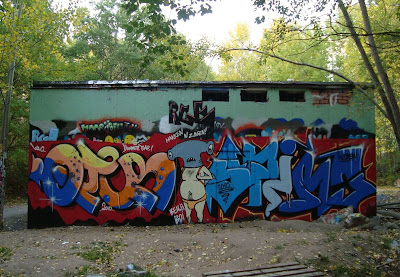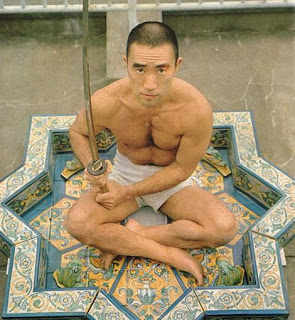>
Category Archives: guest
>One Wall – A collaboration with STHLMGRAFF
>
>Some reflections on the historical pessimism of Yukio Mishima
>
Graduate studies in modern Japanese literature at Ritsumeikan University 2006-2009.
Some reflections on the historical pessimism of Yukio Mishima
By Sven André
I.
Yukio Mishima, pen-name for Kimitake Hiraoka. Born 1925 and raised in a troubled family treasuring its samurai roots. Novelist, playwright, critic, actor, martial artist and commander of his own private nationalist militia Tate-no-kai, the Shield Society. Dies on November 25, 1970, a quarter past noon, from a long, deep wound to his abdomen and the severing of his head with a sword by a young follower. The scene of this ritual of death and dedication is the office of General Kanetoshi Mashita at the Eastern Headquarters of the Japanese Self Defence Forces in Ichigaya, Tokyo. Ten minutes into the past Mishima and his second-in-command, the 25-year-old Masakatsu Morita, are shouting their message of martial honour and national revival, while three other Tate-no-kai members are holding the general hostage in his office. For more than a year Mishima has been preparing himself meticulously for this day when he is to transcend time and existence as we know it. Three hours into the past he is placing a note, a farewell note on his writing desk: “Human life is limited, but I would like to live forever”. When Hiroyasu Koga, after Morita’s botched decapitation attempt, with one powerful stroke of the sword severs Mishima’s head from his body, the limit will be reached and the mystery of eternity revealed to the quickly dying brain. Meanwhile, history will continue to unfold. The universe will go on as if nothing happened. The river flows on, a tiny ripple in the white-foaming cascade of the waterfall is seen for a flicker of a moment and then closed again. Time has come to an end and yet it is neverending. What is the nature of this mighty stream, always in flux and still unchangeable? What was Mishima’s view of it, and of what we call “history”?
II.
As for the future, Mishima apparently regarded it as having little personal importance. His desire to live forever should be interpreted as a longing for a transcendent existence outside of what we call time, the pinnacle moment of beauty and purity stretched into eternity (understood as the atemporal rather than limitless time) and the void, rather than simply a wish for his body of work to survive him as timeless classics. Mishima deeply wanted his death to be that of a man of action, as demonstrated from the fact that he had planned to write the Chinese character signifying “sword” with his own blood after plunging the short sword into his abdomen (a gesture seemingly abandoned for practical reasons). It is also likely that Mishima, despite the support his ideas of a second “Shōwa Restoration” may have enjoyed in certain military circles, had little hope to actually spur a coup d’état with his final action at Ichigaya. The notion, spread by some careless or tendentious writers, that Mishima committed suicide out of disappointment when the Self-Defense Forces refused to rise together with him, is absolutely untrue. The ritual suicide, which in elder days often had served as an act of remonstration performed by the samurai before his master, was part of the plan from the beginning, and Mishima had anticipated the negative response of the soldiers at least two months prior to the event. On the other hand, it is most likely that Mishima would have carried out his rite of death even in the unlikely event that Self Defence Forces would have risen with the Tate-no-kai.
Preparations for the ritual death had been made as prescribed by tradition. The final action was not a mean to serve an end, but a ritualized display of purity and defiance, an act carried out for its own sake. Nowhere is this made more explicitly clear than in the brief “Counterrevolutionary Manifesto” (Han-kakumei sengen) penned by Mishima in February 1969 to sum up the Shield Society’s positions. In this we read that the society, an “embodiment of Japanese beauty”, “the last ones” are to fight a battle which “must be fought once only and must be to the death”. Most significantly, the outcome of this battle is of no decisive importance to the Shield Society: “effectivity is not a concern”. This stance echoes an aristocratic-heroic tradition found not only in Japanese but also in European tradition, wherein the decision to fight from a lost position is met with praise (as Mishima put it in an interview, “Harakiri sometime makes you win”). The Old English poem The Battle of Maldon tells us that “will shall be the sterner, heart the bolder/spirit the greater as our strength lessens”, a sentiment also voiced a thousand years later by J.R.R. Tolkien, a historical pessimist if there ever was one, who poetically described his avatars of creativity and beauty, the dwindling elves, as having “fought the long defeat”. To Mishima, the future meant not the risk of defeat or the possibility of victory as much as the certainty of disillusionment and decay.
III.
An important hint as to Mishima’s view on the nature of time and history towards the end of his life can be found in the book Hagakure Nyūmon (“Introduction to Hagakure”, translated into English as The Samurai Ethic and Modern Japan: Yukio Mishima on Hagakure) which was published in August 1967. Hagakure, “Hidden among the leaves” is an early 18th spiritual and practical guide for the samurai written by Tsunetomo Yamamoto (also known as Jōchō Yamamoto, 1659-1719), a former retainer to Mitsushige Nabeshima (1632-1700), a feudal lord who outlawed the practice of junshi, the traditional suicide whereby a retainer followed his lord in death, thus ironically providing Jōchō, a staunch preserver of tradition, with the opportunity to write down his teachings in old age. During the period in question, the martial traditions of the samurai had led a dwindling existence for over a hundred years, due to the national peace brought by the establishment of the Tokugawa shogunate in 1603. In the view of Jōchō, Japan had become emasculated and dominated by the economistic and hedonistic values of the merchant class. His attitude towards his age was one of stoic pessimism:
The climate of an age is unalterable. That conditions are worsening steadily is proof that we have entered the last stage of the Law [Mappō, the end of the law, the era in Buddhist tradition corresponding to Kali Yuga or Ragnarok]. However, the season cannot always be spring or summer, nor can we have daylight forever. Therefore it is useless to try to make the present age like the good old days a hundred years ago. What is important is to make each era as good as it can be according to its nature. The error of people who are always nostalgic for the old ways lies in their failure to grasp this point. On the other hand, people who only value what is up to date and detest anything old-fashioned are superficial.
Mishima writes that Jōchō is “a realistic observer of the flow of time”, which must mean that he himself, at least to some degree, agreed on the notion that we are living in an age of progressive decline, and that time is cyclical, so that the dark age is followed by a new golden age, where a new, purified world is born out of the ashes of the previous one.
Mishima further remarks that Jōchō is “clearly inconsistent”, for while he declares the “climate of the age” to be “unalterable”, he also laments the decadence of his era. If this can truly be called a contradiction, then it is one which can be found also in the writings of Mishima, from early works such as the arch-romanticist historical fiction of Hanazakari no Mori (A Forest in Full Flower, 1944) to his final great novelistic work, the tetralogy Hōjō no Umi (The Sea of Fertility, 1965-1970), at whose very beginning we find the following description of a photograph taken at a military memorial service held during the Russo-Japanese war (1904-1905):
The figures of these soldiers, in both foreground and rear, were bathed in a strange half-light that outlined leggings and boots and picked out the curves of bent shoulders and the napes of necks. This light charged the entire picture with an indescribable sense of grief.
From these men, there emanated a tangible emotion that broke in a wave against the small white altar, the flowers, the cenotaph in their midst. From this enormous mass stretching to the edge of the plain, a single thought, beyond all power of human expression, bore down like a great, heavy ring of iron on the center.Both its age and its sepia ink tinged the photograph with an atmosphere of infinite poignance.
Among the honoured fallen are the two paternal uncles of the protagonist of the first volume (Spring Snow), Kiyoaki Matsugae. Originally a samurai family, the Matsugaes has joined ranks with a partially westernized aristocracy, with the father of Kiyoaki bearing the title of marquise. The fate of the uncles mirrors that of Kiyoaki. While the latter is an aesthete who abhors the wild shouts of the kendō fencers at school, he too finds his death on the battlefield, although that of romantic love. With the last scion, the last fruit of the family tree fallen, the Matsugaes gradually spiral into ruin and dishonour, as revealed in the subsequent volumes of the tetralogy.
IV.
Did Mishima believe it possible to transcend not only the “climate of the age”, but the decaying nature of time? Certainly, he sought to defy many of the mores and ideals of the times he lived in (or at least, to heckle them). In the 1968 autobiographical essay Sun and Steel we read:
Everything was not, as I had deluded myself, recoverable. Time was beyond recall after all. And yet, as I now realized, the attempt to fly in the face of the relentless march of time was perhaps the most characteristic feature of the way in which, since the war, I had sought to live by committing every possible heresy.
Judging by the same piece of “confessional criticism”, he was not merely opposed to the spirit of the present age, but set against it a – real or imagined – sacralized past:
For me, beauty is always retreating from one’s grasp: the only thing I consider important is what existed once, or ought to have existed.
It is easy to find in those words a correspondence with certain traditionalist notions. There is no indication that Mishima was aware of the writings of so-called perennialist or integral traditionalist thinkers such as René Guenon or Julius Evola, for whom the dichotomy between a superior, transcendent “world of being” and an inferior, immanent “world of becoming” is a central concept, but as an avid reader of German philosophic literature, it is likely that he had come into direct or indirect contact with the thought of the “conservative revolutionaries” of Weimar Germany, who harboured some similar ideas, and the works of Nietzsche always had a quintessential influence on Mishima. Further inspiration may have come from various nationalist-mystical ideas adopted by members of Nippon Rōman-ha, the Japanese Romanticist School, in which periphery Mishima spent early years as an apprentice teenage writer. Most importantly, Mishima was steeped in classic Japanese literature and philosophy. Traditional Japanese culture thinking, with its high regard of ritualized forms and stress on the Buddhist-influenced concepts of mono no aware (the pathos of things) and mujō (transience), naturally encourages the search for transcendent order behind the imperfect and impermanent shapes of the immanent world. Needless to say, those concepts are not wholly unique to Japanese or East Asia, for they have Western counterparts in the lacrimae rerum of Virgil and the mood expressed by the Anglo-Saxon elegies.
If Mishima believed in the possibility of a personal transcendence of time, it was most likely one following the path of ritualized death. At the moment of such a death, he writes (again in Sun and Steel), can the pinnacle of beauty be reached and art and action be united. A self-destructive display of fanatical dedication and “purity” would thus enable, in some inscrutable way, the unveiling of the numina.
In the August 1969 article “A Problem of Culture”, Mishima remarks on the Shinpūren (League of the Divine Wind) incident of 1877, where two hundred fanatically traditionalist samurai, armed with swords only, rose against the modernized Japanese army in the name of the emperor:
Their reckless action and inevitable defeat was necessary to show the existence of a certain essential spirit.
Elsewhere, in a dialogue with Marxist-turned-Nationalist Fusao Hayashi, Mishima noted that the rebellion was «bound to fail, but not before it revealed purity and orthodoxy and the substance, call it core, of what we mean when we speak of Japan and the Japanese».
It almost need not be mentioned that the few rebels that did not fall for the onslaught of bullets all committed seppuku. Clearly Mishima, in his final action, set out to emulate the purpose he ascribed to the Shinpūren. Armed with Japanese swords only – a token of “purity” – he and his Tate-no-kai cadets were to reveal “a certain essential spirit” to the soldiers of the Self Defence Forces, who, according to Mishima’s speech from the Ichigaya balcony, unless they rose with the Tate-no-kai, would end up as “a soulless arsenal”, “American mercenaries” in a Japan that had “no spiritual foundation”. With this action, Mishima would deal a final blow against the “relentless march of time” and at the same time disappear into the rift opened in it through the violent display of an atemporal, transcendent “purity”.
V.
In the August 1955 essay “Departure from a sense of finality” (Shūmatsukan kara no shuppatsu), Mishima claims that the end of World War II and the defeat of Japan to him “was not an especially sorrowful event”, and this may be true, especially when compared to the death of his beloved sister Mitsuko shortly after the war’s end, but there’s no escaping that it came to take on an increasing significance in his writing. Mishima’s American biographer John Nathan writes that the news of the defeat “seems to have struck him with the somehow unidentifiable force of a presentiment”, and goes on to quote from the 1945 short story “A Tale at the Cape” (Misaki nite no monogatari), in which an eleven-year-old boy become witness to the love suicide of a young couple and experiences an eerie feeling of abandonment. Nathan also quotes from “August 15, Before and After” (Hachigatsu jūgonichi zengo), a reminiscence written in August 1955, wherein Mishima relates his own impressions from the day of defeat ten years earlier:
A summer meadow stretched in front of me. In the distance I could see the barracks. And above the woods sailed quite summer clouds. If the war had really ended, that scenery would suddenly have altered its significance. Perhaps I couldn’t have identified just how it had changed, but the meadow, those woods and those clouds must now have become part of a world we had never before experienced. In that instant, I felt I had glimpsed a world of a different sensuous dimension.
The inner sensation supposedly experienced by him in this moment was one of profound confusion and dislocation: “I had the strange feeling that I had suddenly fallen through the ground”. In Sun and Steel, we find the same reflection:
The war ended, yet the deep green weeds were lit exactly as before by the merciless light of noon, a clearly perceived hallucination stirring in a slight breeze; brushing the tips of the leaves with my fingers, I was astonished that they did not vanish at my touch.
The world remains the same, yet something is different. An invisible, untouchable shroud of beautiful nothingness has been torn away, leaving the dry bones of mundane reality, oblivious to the heart and its dreams.
In The Temple of the Golden Pavilion (1956), the war and its imminent threat of destruction permit the ugly, stuttering temple acolyte Mizoguchi to sense a metaphysical unity with the golden temple which to him is the apotheosis of beauty. When the war ends without the American B-52s showing up to rain fire and destruction over Kyoto, his co-existence with Beauty is torn asunder:
The war ended. All I was thinking about, as I listened to the Imperial Rescript announcing the surrender, was the Golden Temple. The bond between the temple and myself had been severed. I thought, now I shall return (…) to a state in which I exist on one side and beauty on the other. A state which will never improve so long as the world endures.
This nihilistic division of history into a past where this apocalyptic threat brought into flower the sensation of pure existence, and a barren present, recalls one of the aphorisms from Cioran’s early work Tears and Saints:
This world must once have lived in God. History divides itself in two: a former time when people felt pulled towards the vibrant nothingness of divinity and now, when the nothingness of the world is empty of the divine spirit.
To Mishima, “God“, or the Absolute was immanent in the transcendental quality of the emperor system, which to him was not only the heart of the Japanese culture, but a mystical absolute central value enabling the verification of love and existence. The Shōwa emperor’s “declaration of humanity” (ningen sengen) – the renouncement of the emperor’s divine nature – following the end of World War Two was therefore in his view something of a denunciation of the Absolute and an emptying of existence, which he lamented in particular in his 1966 short story cum essay Eirei no koe (Voices of the Heroic Dead). In this he lets the ghosts of Kamikaze pilots ask the living: nadote sumerogi wa hito to naritamaishi? (“Why did the Emperor have to become a human being?”). Yet, throughout Mishima’s writings, such as in the third volume of The Sea of Fertility (The Temple of Dawn) there are hints suggesting that all efforts in our day and age to return to a state of transcendence and tradition, pure or impure as they may be, are tragic, futile attempts to stall the inevitable. The world is set on a steady course away from the divine, and has been so since time immemorial.
VI.
What of beauty? Is it, too, subject to the ruin of time, or does it harbour some atemporal aspect? In the writings of Mishima, beauty tends to be either inescapably linked to the physical world, and in particular to the human body, which beauty is doomed to decay and can be saved only momentarily – yet, perhaps, in a moment outside of time – by being destroyed at its zenith of perfection, or else portrayed, like in the previous quote from Sun and Steel, as something “always retreating from one’s grasp”; a paradoxical, shining nothingness haunting the sensible human mind like some ghostly vessel of the divine void, the nada of the mystics. In Mishima’s foremost work dealing with the latter, ethereal variant of beauty, The Temple of the Golden Pavilion, the Kyoto temple of the title is described by the narrator, the obsessive, “evil” acolyte Mizoguchi as “a nihility that had been designed and constructed with the most exquisite care”. The Golden Temple’s “apparently indestructible beauty” towers before the protagonist “like some terrifying pause in a piece of music”, paralyzing his very sense of existence while at the same time constituting his raison d’être.
At the end of the novel, however, Mizoguchi “sets free” the beauty of the temple by destroying the building with fire, and thereby also regain his will to live. His tortuous transition from passive to active nihilism also carries a tinge of nostalgia for a past “ruled by Buddhist law” where destruction by fire – and subsequent regeneration – was “the order of the day”. The unspoken irony of the novel is the fact that the temple just a few years later was rebuilt and its splendour resurrected, just like the phoenix portrayed on the top of its gleaming roof. The idea of beauty – and the human longing for it – endures the destruction of its visible forms.
The inevitable decay of manifest beauty and the impossibility of “purity” in a world dominated by economistic and “humanistic” values are themes that recur throughout Mishima’s later novels, and especially in his major opus The Sea of Fertility. In the final volume of the tetralogy, The Decay of the Angel (Tennin Gosui, 1970), a masterpiece of subdued beauty and utter bleakness, time has run its course, life forces have come to their ends, a world has been lost. The idealism, dedication and romanticism displayed by the protagonists of the first two volumes have been replaced with vapidity, scheming calculation and narcissism. The book is filled with lyrical meditations on finality and decay, such as the passage wherein the observer-protagonist Honda describes one of the sceneries from the Kitano picture scroll in a haunting soliloquy on the subject of the death of angels:
The gold dust of all-powerful beauty and pleasure drifts down. Absolute freedom soaring in emptiness is torn away like a rending of flesh. The shadows gather. The light dies. Soft power drips and drips from the beautiful fingers. The fire flickers in the depths of flesh, the spirit is departing.
The brightly checkered floor of the pavilion, the vermillion balustrades, have faded not at all. Relics of grandeur, they will be there when the angels are gone.
Beneath shining hair beautiful nostrils are turned upward. The angels seem to be catching the first fore-scent of decay. Petals twisting beyond clouds, azure decay coloring the sky, all pleasures of sight and spirit, all the joyous vastness of the universe, gone.
The “angel” (tennin) of The Sea of Fertility is of course the repeatedly reincarnated (or apparently reincarnated) young protagonist of the four novels, but it is hard to escape the notion that their fate is supposed to mirror the history of modern Japan as Mishima perceived it (the third volume, The Temple of Dawn, appears to be an exception with its settings in Thailand and India, but the sensuousness and archetypically female traits of the protagonist Ying Chan may be linked to the notion of hedonism and “national emasculation” as characteristics of post-war Japan (trends actively promoted by the American occupational authorities, as shown by John Dower in his study Embracing Defeat), which crops up elsewhere in Mishima’s writings). Thus the pathos apparent in the photograph described at the beginning of Spring Snow has by the end of The Decay of the Angel been replaced with an air of pathetic dissolution, as in the sceneries of shallow affluence observed by the aged Honda on his way from Tokyo to Nara:
Waiting with several women and children at a bus stop was a pregnant woman, warm in a bold Western print. The faces wore a certain stagnation, as of tea leaves floating on the torrents of life. Beyond was a dusty tomato patch.
The Daigo district was a clutter of all the dreary details of new construction, to be seen throughout Japan: raw building materials and blue-tiled roofs, television towers and power lines, Coca-Cola advertisements and drive-in snack bars.
The historical pessimism and the theme of decaying beauty are not specific to Mishima’s later period (usually considered to have begun with the publication of the short story “Patriotism” (Yūkoku) in the summer of 1960). In fact, it harks back to his very earliest works published during the war years, such as the already mentioned Hanazakari no Mori, wherein we encounter passages such as the following:
Now Beauty is a gorgeous, runaway horse. But there was a time when it was reined in and stood quivering in its tracks and neighing shrilly at the misty morning sky. Only then was the horse clean and pure, graceful beyond compare. Now severity has let go the reins; the horse stumbles, regains its footing, plunges headlong. It is no longer immaculate, mud cakes its flank. Yet there are times even now when a man will see the phantom of an immaculate white horse.
It is likely of significance that the comparison of beauty to a white horse does not only relate to the concept of purity, but also brings to mind more specifically the horse of the emperor which, according to court traditions, has to be pure white. This imperial steed would reappear a quarter of a century later in Eirei no koe, bearing the “man who is a god”. Thus beauty is connected with purity, which in turn is linked to tradition and the perceived incarnation of the godhead, the numina now wrapped in the grey dusk of decay and disintegration, waiting for someone of sufficient “purity” to tear the dark clouds apart with a flashing sword.














